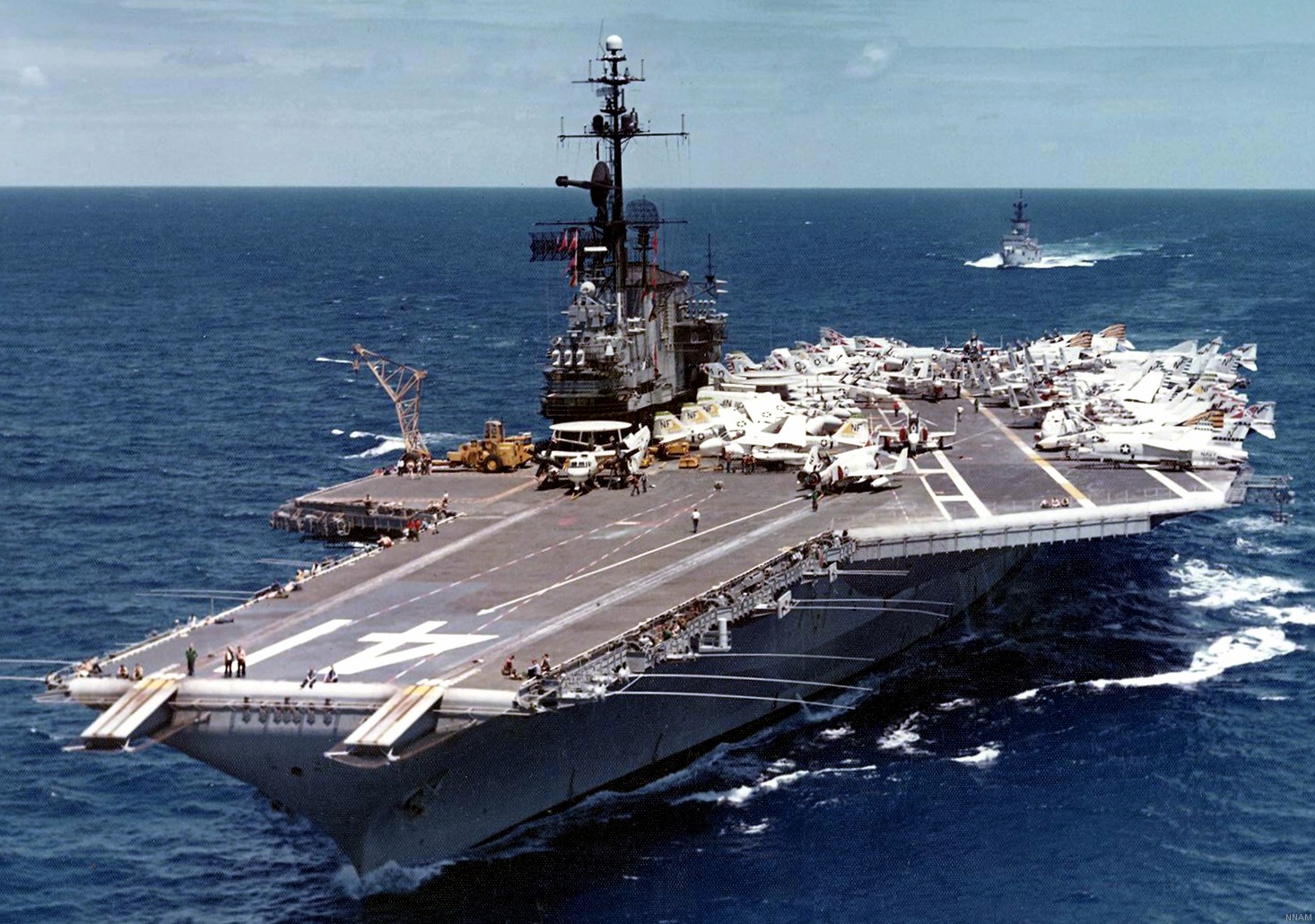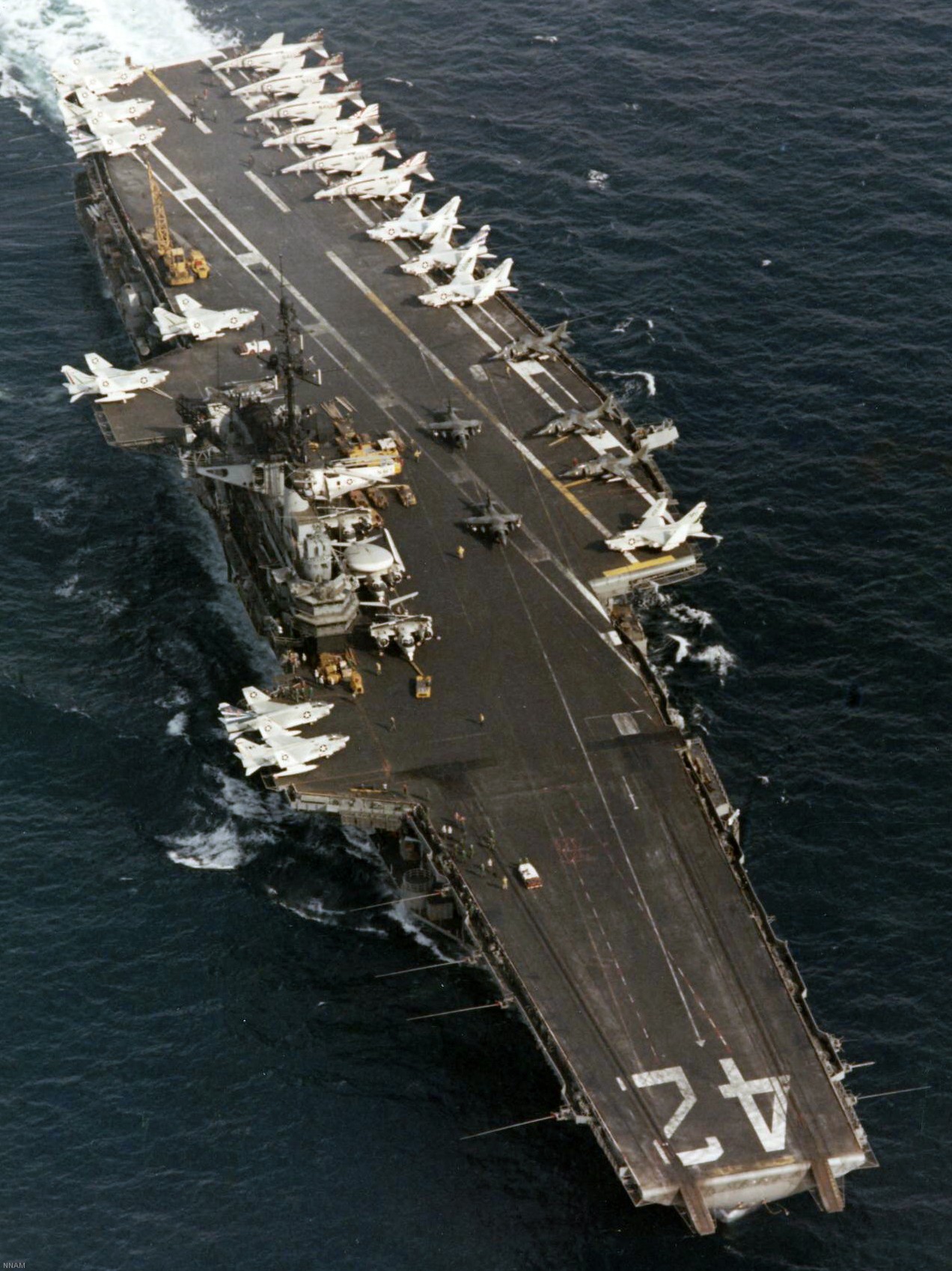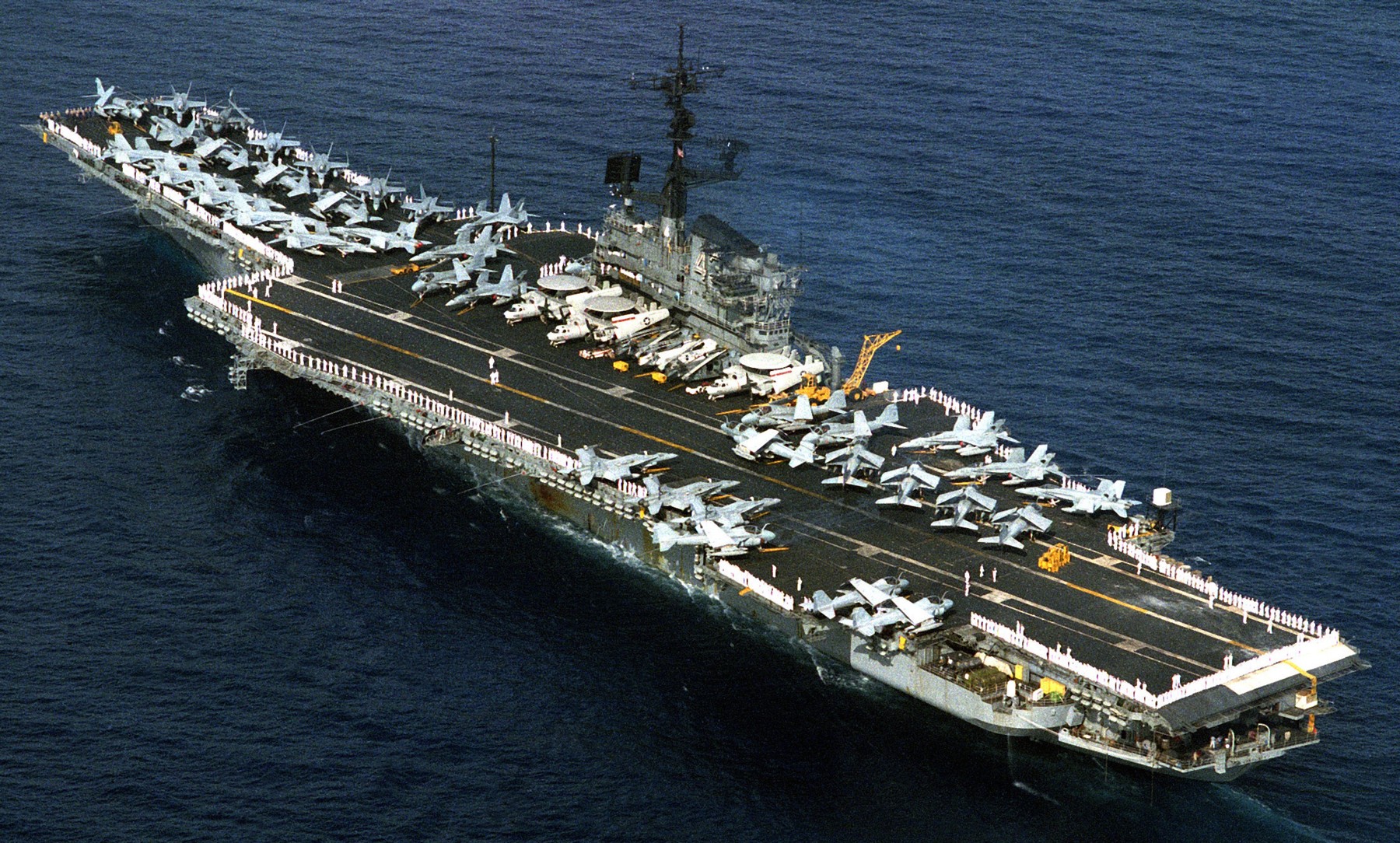 |
|
|
HOME
|
US Navy -
ships
|
US Navy - air
units
|
USMC - air
units
|
International
Navies
|
Weapon Systems
|
Special Reports |
|
|
US Navy Midway class Aircraft Carrier |
|
 |
|
| 12/23 | |
| Ships: | |
|
|
| Specifications (as built): | |
|
|
|
Concept/Program These ships were a new, much larger design intended to correct certain problems in the Essex class design. They had armored flight decks, requiring a much larger hull and lower freeboard, to reduce topweight. They also carried a very heavy AA battery of 5/54 weapons. The armor requirement was originally meant to counter 8" cruiser gunfire, but by the time the ships were laid down the focus had shifted to defending against aircraft attack. The ships entered service soon after WWII. In their early years they were the only ships capable of operating nuclear strike aircraft. Design An all-new design. These ships were very wet, very crowded and quite complex; these problems were never solved. The design made them difficult and expensive to modernize or upgrade. In later years these ships were limited by low freeboard, severe crowding of crew and equipment, low hangar clearances, poor seakeeping and extreme age; they were unable to operate the latest and largest aircraft. Overall they must be considered to be a less than satisfactory design, but they had long service lives because of the urgent need for large carriers. Variations Configurations varied as completed; only Midway was completed to the original design. Roosevelt and especially Coral Sea carried fewer guns at completion. There were major differences following the 1950's reconstructions. Modifications All ships had their gun batteries gradually reduced over time. All ships were upgraded in 1947-48 with strengthened flight decks, 10 dual 3/50 AA fitted in place of 40 mm guns, facilities for nuclear weapons, and other improvements. Continual updating of electronics outfit. Modernization Underwent major reconstructions during the 1950's, but no two ships were reconstructed to the same standard. These rebuilds were the equivalent of the SCB 27C/125 reconstructions in the Essex class. SCB 110 (Midway & Roosevelt) First reconstruction applied to this class, generally equivalent to the SCB 27C/125 combination. Additions included an angled deck, new catapults and arresting gear and a new electronics outfit; the gun battery was reduced and general improvements were carried out. Displacement was approximately 63,500 tons. SCB 110A (Coral Sea) A more extensive version of the SCB 110 applied to the other ships of the class. Aviation features and electronics were further improved, and gun battery was further reduced. SCB 101 (Midway) A second reconstruction meant to be applied to all ships, to upgrade them beyond the SCB 110/110A configuration. This reconstruction included a longer flight deck, new catapults, and general all-around improvements. Due to the cost of this work, only one ship was upgraded under this program. After SCB 110A Coral Sea was the most capable of the ships, but Midway surpassed her with the SCB 101 reconstruction. In addition to the SCB reconstructions, each ship received at least one major overhaul/upgrade, the details of which varied. Classification Initially classified as CV, but changed to CVB prior to completion, and CVA postwar. Returned to CV classification in 1975 when modified to operate ASW aircraft. Operational Saw extensive service as tactical and strategic platforms. Operational lives continually extended due to force level build-ups and lack of replacements. - - - - - CV 41 - CVB 41 - CVA 41 - CV 41 USS Midway Built by Newport News. Designation changed from CV 41 to CVB 41 15 July 1943. Laid down 27 Oct 1943, launched 20 Mar 1945, commissioned 10 Sept 1945. Redesignated as an attack carrier (CVA 41) 1 October 1952. SCB 110 reconstruction at Bremerton Navy Yard started July 1955, completed and recommissioned 30 Sept 1957. Second reconstruction, SCB 101 at San Francisco Navy Yard, started 15 Feb 1966; completed and recommissioned 31 Jan 1970. Forward deployed in Japan from 1973 to decommissioning. In 1975 she disembarked her air wing at Subic Bay and embarked transport helicopters to assist in Operation Frequent Wind, the evacuation of US personnel from South Vietnam. She returned to Subic Bay carrying over 100 helicopters and other aircraft which had escaped from Vietnam, and hundreds of evacuees. Redesignated as a multi-mission aircraft carrier (CV 41) 30 June 1975, but she did not embark anti-submarine aircraft. Final overhaul in 1986 in Japan; new bulges were added to improve freeboard and seakeeping. The bulges actually made the problem worse, making flight operations impossible in 6-10 foot seas. This problem was never corrected. From the late 1970's on this ship was subject of frequent replacement proposals, but she continued in service as carrier force levels were increased. Was one of the primary ships involved in Operation Fiery Vigil, the evacuation of Subic Bay, Clark AFB and Cubi Point following volcanic eruptions. Replaced as forward deployed carrier by Independence in 1991 and returned to the US for decommissioning. Decommissioned to reserve 11 April 1992; retained as a potential replacement training carrier. Inactivation overhaul included stripping all electronics and weapons systems. Stricken for disposal 17 March 1997; remains stored at Bremerton pending disposal. May be preserved at San Diego, CA. Characteristics immediately prior to decommissioning: USS Midway, as retired (1992) Displacement: 69,873 tons full load Length: 976 feet/297.5 meters Beam: 263.5 feet/80.3 meters Draft: 35 feet/10.7 meters Armament: 2 x 8-cell Sea Sparrow launchers, 2 x Mark 71 mod 0 Phalanx CIWS Speed: 33 knots (61 km/h) Power: 212,000 hp (158 MW) Drive: 4 screws; geared turbines Aircraft: 75 - - - - - CV 42 - CVB 42 - CVA 42 - CV 42 USS Franklin D. Roosevelt Built by New York Navy. Designation changed from CV 42 to CVB 42 15 July 1943. Laid down 1 Dec 1943, launched 29 April 1945, renamed to honor deceased President 8 May 1945, commissioned 27 Oct 1945. Redesignated as an attack carrier (CVA 42) 1 October 1952. SCB 110 reconstruction at Bremerton Navy Yard 23 April 1954, completed and recommissioned 6 April 1956. Second rebuild (SCB 101) cancelled due to cost. Received austere overhaul in 1968 to correct some of the most serious deficiencies. Redesignated as a multi-mission aircraft carrier (CV 42) 30 June 1975, but she did not embark anti-submarine aircraft. During her last deployment she operated AV-8 Harriers on a trial basis, to test the possibility of including VSTOL aircraft in carrier air wings. Decommissioned and stricken for disposal 1 Oct 1977. Sold for scrapping 11 April 1978 and scrapped at Kearny, NJ in 1980. - - - - - CV 43 - CVB 43 - CVA 43 - CV 43 USS Coral Sea Built by Newport News. Designation changed from CV 43 to CVB 43 15 July 1943. Laid down 10 July 1944, launched 2 April 1946, commissioned 1 Oct 1947. Gun battery was much reduced at completion compared to other ships of the class. Redesignated as an attack carrier (CVA 43) 1 October 1952. Underwent short refit 9/1955 to 2/1956. SCB 110A reconstruction at Bremerton Navy Yard 3/1957, completed and recommissioned 25 Jan 1960. Second modernization (SCB 101) cancelled. From the late 1970's on this ship was subject of frequent replacement proposals, but she continued in service as carrier force levels were increased. Redesignated as a multi-mission aircraft carrier (CV 43) 30 June 1975, but she did not embark anti-submarine aircraft. Began deactivation and stripping 10/89 at the start of the post-Cold War carrier force level drawdown. Decommissioned and stricken for disposal 30 April 1991. Sold for scrapping 30 March 1993. Scrapped at Baltimore starting 1993; scrapping was been delayed by numerous financial, legal and environmental issues; finally completed 8/2000. Characteristics immediately prior to decommissioning: USS Coral Sea, as retired (1991) Displacement: 65,200 tons full load Length: 1003 feet/305.7 meters Beam: 236 feet/72 meters Draft: 35 feet/10.7 meters Armament: 3 Phalanx CIWS Speed: 33 knots (61 km/h) Power: 212,000 hp (158 MW) Drive: 4 screws; geared turbines Aircraft: 65 |
|
|
images (for more images go to the individual ship pages) |
|
 CV 41 USS Midway  CV 42 USS Franklin D. Roosevelt  CV 43 USS Coral Sea |
|
| | seaforces.org | USN ships start page | |